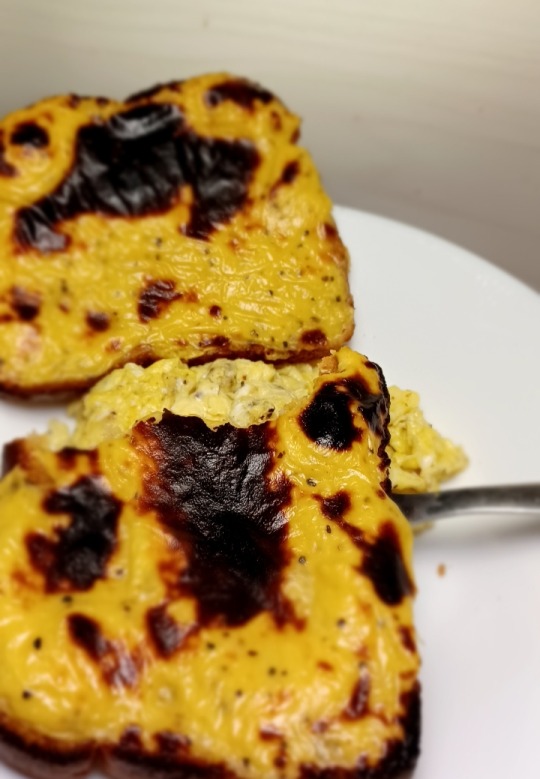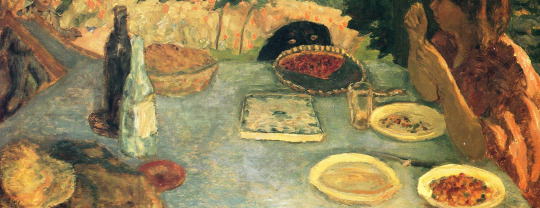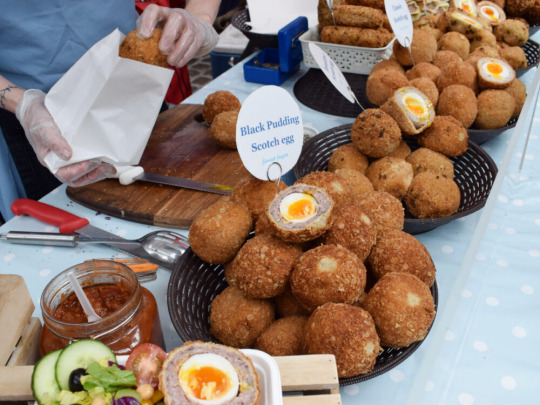#Rarebit recipe
Explore tagged Tumblr posts
Text
Nettle and Green Onion Rarebit (Vegetarian)

After a few hours spent gardening, sowing, planting, weeding and tilling, how satisfying to return in the kitchen with freshly dug go, and freshly snipped (very carefully, with gloves!) nettle. These Nettle and Green Onion Rarebit, inspired from a recipe in this month's Simple Things, make the harvest all the more delicious! Happy Thursday!
Ingredients (makes 4 slices):
a large Green Onion
2 tablespoons unsalted butter
2 tablespoons plain flour
1 cup semi-skimmed milk
a pinch of fleur de sel or sea salt flakes and freshly cracked black pepper
nutmeg
Mature English Cheddar
4 small slices White Bloomer Bread
1 tablespoon unsalted butter
1 cup freshly picked nettles (wearing gloves), leaves removed from the stalks and thoroughly washed under cold water (wearing rubber gloves!)
Preheat oven to 250°C/480°F.
Finely chop Green Onion.
Melt butter in a medium saucepan over a medium flame. Once butter is just foaming, add chopped Green Onion, and cook, a couple of minutes.
Sprinkle in the flour. Give a good stir, and cook out, 1 minute.
Remove from the heat, and gradually stir in the milk, to prevent lumps, so the mixture is smooth and loose. Return over medium heat, and cook, stirring constantly until the sauce thickens. Once the béchamel thickens, season with fleur de sel and black pepper. Grate in about 1/4 teaspoon nutmeg. Then, grate in 1/3 cup Mature English Cheddar. Give a good stir until melted. Remove from the heat.
Place White Bloomer Bread slices onto a pizza pan, and place in the middle of the hot oven. Toast, at 250°C/480°F, 4 minutes.
Melt butter in a small frying pan over medium-high heat. Once the butter is just foaming, add the nettle leaves, and sauté, a couple of minutes until wilted. Transfer to a chopping board, and chop finely. Stir nettle leaves into the cheesy béchamel.
Flip White Bloomer Bread slices on their other side, and spoon cheesy nettle and green onion béchamel onto each slice. Grate a little more Cheddar on top and return to the hot oven. Bake, at 250°C/480°F, 3 to 4 minutes, until bubbly.
Sprinkle Nettle and Green Onion Rarebit with chopped green part of the Green Onion, and serve immediately, with a glass of chilled white wine, like Chardonnay or Sauvignon Blanc.
#Recipe#Food#Nettle and Green Onion Rarebit#Nettle and Green Onion Rarebit recipe#Rarebit#Rarebit recipe#Bread#White Bloomer Bread#Béchamel#Béchamel Sauce#Butter#Flour#Milk#Nutmeg#Fleur de Sel#Black Pepper#Black Peppercorns#Cheddar#Mature English Cheddar#Nettles#Garden Nettles#Green Onion#Garden Green Onion#Garden Vegetables#Garden Weeds#Foraging#Growing Gardening and Foraging#Thrifty#Thrifty recipe#Thrify Thursday
7 notes
·
View notes
Text

From a 1941 cookbook
12 notes
·
View notes
Text

Blushing Bunny
-Success in Seasoning 1930
15 notes
·
View notes
Text
I made Welsh rarebit.

I've been wanting to try it since Woodcock ordered it in that sexually charged scene in Phantom Thread.
It was really good. I finally found a recipe that didn't use Guiness.

I put it too close to the broiler. I used yellow mustard, hence the yellow color, instead of Dijon or brown. Mustard. For the cheese, I used Gouda.
I wonder what would happen if I left out the egg yolk?
I give the English a lot of shit about their food, but they did something when they made this.
#welsh rarebit#phantom thread#reynolds woodcock#alma elson#recipes#home cooking#english food#Welsh cuisine#English cuisine
6 notes
·
View notes
Text
The Welsh Riviera,Ruth Jayne Lewis local artist,Quiche Lorriane,Flapjacks,French Onion & Leek Soup,Welsh Rarebit,To Catch A Thief.
Luke 6:38 38 Practice giving, and people will give to you. They will pour into your laps a fine measure, pressed down, shaken together, and overflowing. For with the measure that you are measuring out, they will measure out to you in return.” The Welsh Riviera The Welsh Riviera is a region in Wales that includes the south coast of the Llŷn Peninsula and the town of Tenby in…

View On WordPress
#Beaches in Wales#Bible#encouragement#europe#Flapjacks#French Onion Soup#Gower#history#Hobnobandslippers#Llyn Penninsula#north-wales#Onion and Leek soup recipe#Quiche Lorraine#Ruth Lewis art#scriptures#Tenby#travel#Visit Wales#Wales#Welsh Rarebit#Welsh Riviera#Wendies blog
0 notes
Photo

Sauces - Real Welsh Rarebit This Welsh rarebit recipe is a smooth and creamy cheese sauce made with beer that's served over toasted bread or English muffins for a quick meal.
0 notes
Text

English Monkey appears to be a New England variation of Welsh Rabbit/Rarebit. And I have now learned of another variation called Blushing Bunny which uses tomato soup. No monkeys or rabbits are harmed in the making of these dishes.
Found in 1947’s “Cooking is Fun” — Sponsored by the Organizations of Calvary Methodist Church in Lewiston, Maine.
1 note
·
View note
Text
A Writer's Recipes George Orwell

Recipes (Christmas Pudding; Orange Marmalade; Plum Cake; Treacle Tart; Welsh Rarebit; Yorkshire Pudding)
Excerpts from the article, "British Cookery" commissioned by the British Council in 1946 but was unpublished
CHRISTMAS PUDDING
Ingredients:
1 lb each of currants, sultanas & raisins 2 ounces sweet almonds 1 ounces bitter almonds 4 ounces mixed peel ½ lb brown sugar ½ lb flour ¼ lb breadcrumbs ½ teaspoonful salt ½ teaspoonful grated nutmeg ¼ teaspoonful powdered cinnamon 6 ounces suet The rind and juice of 1 lemon 5 eggs A little milk 1/8 of a pint of brandy, or a little beer
Method. Wash the fruit. Chop the suet, shred and chop the peel, stone and chop the raisins, blanch and chop the almonds. Prepare the breadcrumbs. Sift the spices and salt into the flour. Mix all the dry ingredients into a basin. Heat the eggs, mix them with the lemon juice and the other liquids. Add to the dry ingredients and stir well. If the mixture is too stiff, add a little more milk. Allow the mixture to stand for a few hours in a covered basin. Then mix well again and place in well-greased basins of about 8 inches diameter. Cover with rounds of greased paper. Then tie the tops of the basins over the floured cloths if the puddings are to be boiled, or with thick greased paper if they are to be steamed. Boil or steam for 5 or 6 hours. On the day when the pudding is to be eaten, re-heat it by steaming it for 3 hours. When serving, pour a large spoonful of warm brandy over it and set fire to it.
In Britain it is usual to mix into each pudding one or two small coins, tiny china dolls or silver charms which are supposed to bring luck.
ORANGE MARMALADE (handwritten note – ‘Bad recipe!’ –‘too much sugar and water’)
Ingredients:
2 seville oranges 2 sweet oranges (no) 2 lemons (no) 8 lbs of preserving sugar 8 pints of water
Method. Wash and dry the fruit. Halve them and squeeze out the juice. Remove some of the pith, then shred the fruit finely. Tie the pips in a muslin bag. Put the strained juice, rind and pips into the water and soak for 48 hours. Place in a large pan and simmer for 1 1/2 hours until the rind is tender. Leave to stand overnight, then add the sugar and let it dissolve before bringing to the boil. Boil rapidly until a little of the mixture will set into a jelly when placed on a cold plate. Pour into jars which have been heated beforehand, and cover with paper covers.
PLUM CAKE
Ingredients:
¾ 1b butter ½ 1b sugar 4 eggs ¾ 1b flour ¼ lb crystallised cherries ¼ Ib raisins ¼ lb sultanas ¼ lb chopped almonds ¼ lb mixed candied peel The grated rind of 1 lemon and 1 orange ½ teaspoonful of mixed spice A pinch of salt 1 glass brandy
Method. Beat the butter and sugar to a cream; add each egg separately and beat until the mixture is stiff and uniform. Sift the flour with the mixed spice and the salt, stir well into the creamed mixture, add the raisins (stoned beforehand), the cherries cut in halves, and the sultanas, the candied peel cut into small pieces, the grated lemon and orange rind, add the brandy. Mix thoroughly, put into a round tin lined with greased paper, put into a hot oven for 10 to 15 minutes, then reduce the heat and bake slowly for 3 ½ hours.
TREACLE TART
Ingredients:
12 ounces short crust pastry Golden syrup 2 ounces breadcrumbs A pinch of ginger or a little lemon juice
Method. Make the pastry crust in the proportion of eight ounces of flour to five ounces of butter, with a pinch of salt, and mix with cold water. Line a flat metal dish with the pastry. Cover with a layer of bread crumbs, then pour in the golden syrup. Sprinkle lemon juice or ginger over the syrup and cover with the remainder of the crumbs. Bake for 30 minutes in a hot oven.
WELSH RAREBIT
Ingredients:
1 ounce butter 4 ounces cheese (coarsely grated) 1 tablespoonful milk or beer ½ teaspoonful made mustard Pepper and salt
Method. Melt the butter in a saucepan. Add the milk, salt, mustard and cheese. Heat and stir until the cheese has melted. Pour on to slices of hot buttered toast which have been prepared beforehand. Serve immediately.
YORKSHIRE PUDDING
Ingredients:
4 ounces flour 1 or 2 eggs ½ teaspoonful salt ½ pint milk (or milk and water)
Method. Put the flour into a basin with the salt. Make a well in the centre, break in the eggs; beat well, adding the milk to make a think batter; allow this to stand for 2 hours. Melt some dripping in a baking-tin and when quite hot pour in the batter. Make for half an hour in a hot oven.
More: George Orwell
#george orwell#recipes#food#literature#writing reference#dark academia#spilled ink#writeblr#writing inspiration#light academia#writers on tumblr#poets on tumblr#writing prompt#poetry#pierre bonnard#post impressionism#writing resources
63 notes
·
View notes
Text
making fancy Welsh rarebit/rabbit for father's day with good cider and irish cheddar and i keep staring at the recipe open and trying not to drool lmao
4 notes
·
View notes
Text
REGIONAL SPECIALITIES

Despite recent setbacks beef is still big industry in England, and the Scottish Aberdeen Angus is one of our most famous beef-producing breeds. Dairy cattle are also farmed extensively -- England is famous for its creams and butters and for its sturdy and delicious cheeses: Stilton, Cheshire and its rare cousin blue Cheshire, double Gloucester, red Leicester, sage Derby, and of course cheddar.
Some of our more interesting dishes include:-
Beefsteak, Oyster, and Kidney Pudding: Oysters may seem unlikely in this meat pudding, but their great abundance in the Victorian age and earlier eras inspired cooks to find ways to incorporate them creatively in many different recipes. This steamed pudding combines the meats with mushrooms, onions, tomatoes, and Worcestershire, then wraps the whole in a suet pastry.
Black Pudding: invented in Stornoway, Isle of Lewis black pudding is often served as part of a traditional full English breakfast.
Black Pudding Recipe
Cock-a-Leekie : This Scottish specialty can be classified as a soup or a stew. It combines beef, chicken, leeks, and prunes to unusual and spectacular ends.
Crown Roast Lamb: The crown roast encircles a stuffing of apples, bread crumbs, onion, celery, and lemon.
Eccles Cake : Puff pastry stuffed with a spicy currant filling.
Hasty Pudding: A simple and quick (thus the name) steamed pudding of milk, flour, butter, eggs, and cinnamon.
Irish Stew: An Irish stew always has a common base of lamb, potatoes, and onion. It could contain any number of other ingredients, depending on the cook.
Likky Pie Leeks: pork, and cream baked in puff pastry.
Mincemeat: Beef suet is used to bind chopped nuts, apples, spices, brown sugar, and brandy into a filling for pies or pasties - not to be confused with minced meat!.
Mulligatawny Soup: What this soup is depends on who is cooking it. Originally a south Indian dish (the name means pepper water in tamil), it has been adopted and extensively adapted by the British. Mullitgatawny contains chicken or meat or vegetable stock mixed with yogurt or cheese or coconut milk and is seasoned with curry and various other spices. It is sometimes served with a separate bowl of rice.
Syllabub: In the seventeenth century, a milkmaid would send a stream of new, warm milk directly from a cow into a bowl of spiced cider or ale. A light curd would form on top with a lovely whey underneath. This, according to Elizabeth David, was the original syllabub. Today's syllabub is more solid (its origins can also be traced to the seventeenth century, albeit to the upper classes) and mixes sherry and/or brandy, sugar, lemon, nutmeg, and double cream into a custard-like dessert or an eggnog-like beverage, depending upon the cook.
Trifle: Layers of alcohol-soaked sponge cake alternate with fruit, custard and whipped cream, some people add jelly, but that's for kids.
Welsh Faggots: Pig's liver is made into meatballs with onion, beef suet, bread crumbs, and sometimes a chopped apple. Faggots used to be made to use up the odd parts of a pig after it had been slaughtered.
Welsh Rabbit (or Rarebit): Cheese is grated and melted with milk or ale. Pepper, salt, butter, and mustard are then added. The mix is spread over toast and baked until "the cheese bubbles and becomes brown in appetizing-looking splashes" (Jane Grigson in English Food, London: Penguin, 1977).
Westmoreland Pepper Cake: Fruitcake that gets a distinctive kick from lots of black pepper. Other ingredients include honey, cloves, ginger, and walnuts.
Hand, L.R. (2019). British Food - British culture, customs and traditions. [online] Learnenglish.de. Available at: https://www.learnenglish.de/culture/foodculture.html.
2 notes
·
View notes
Photo

Cheese Dips and Spreads - Welsh Rabbit I believe this recipe is the same as Welsh Rarebit, the classic British topping for rye or white bread toast. Melted sharp Cheddar cheese is complimented by Worcestershire sauce and a hint of cayenne pepper.
2 notes
·
View notes
Text
The Rugby World Cup Table

In France, there is something specific to Rugby we call "la troisième mi-temps" (third half-time), where both winning and losing teams and supporters gather after a game for a bite and a pint! In that spirit, as our home World Cup comes to a close tonight, I am celebrating all the teams that took part and played exciting, enthralling rugby (sometimes breaking our hearts!) all across France this past couple of months, sharing recipes from all the countries represented. I really enjoyed delving into national cuisines I did not know, and perhaps some future travels will be inspired by these delicious discoveries! In the meantime, I'll be happy eating, whether New Zealand or South Africa lifts their fourth Webb Ellis Trophy!
Pool A
Confit Duck (France)
Manuka Honey Glazed Ham (New Zealand)
Melanzane alla Parmigiana (Italy)
Pasta con Salsa Caruso (Uruguay)
Ombidi and Mielie Pap (Namibia)
Pool B
Beer Battered Sausages (Ireland)
Regte Braaibroodjie (South Africa)
Scots Apple Crumble (Scotland)
Ota Ika (Tonga)
Griș cu Lapte (Romania)
Pool C
Haddock Welsh Rarebit (Wales)
Vudi Vakasoso (Fiji)
Aussie Burgers (Australia)
Pastéis de Nata (Portugal)
Abkhazura (Georgia)
Pool D
Chicken Pot Pie (England)
Guiso Carrero (Argentina)
Salmon Chirashi (Japan)
Kopai (Samoa)
Chupe de Camarones (Chile)
#Recipes#Food#The Rugby World Cup Table#The Rugby World Cup Table recipes#The Rugby World Cup Table Recipe List#Rugby World Cup#RWC#Rugby World Cup 2023#RWC 2023#France 2023#French Cuisine#New Zealand Cuisine#Namibian Cuisine#South African Cuisine#Italian Cuisine#British Cuisine#Irish Cuisine#South American Cuisine#Portuguese Cuisine#Romanian Cuisine#Georgian Cuisine#Pasifika Cuisine#Japanese Cuisine#Rugby#Food and Sport
4 notes
·
View notes
Note
What is your countries national dish or food?
Hi River, I'm so sorry it's taken me this long to get to answering your question so I hope this will suffice.
Ériu - Stobhach Gaeilge, is one of those hearty stews that sticks to your ribs and warms your soul when have a bowl. The ingredients vary from person to person, but it's a traditional recipe that everyone knows.
Caledonia - Scones, never let their southern neighbor's tell you they invented them. They didn't these babies are all Caledonian. They get their name from Scone Palace where the Stone of Destiny resides and where the kings of old were crowned.
Cymru - Cymraeg rarebit is an odd one but it's delicious. It's the ultimate version of cheese on toast.
Kernow - Saffron Bun, soft warm with a bright yellow color stuffed with currants perfect for tea time.
Albion - Yorkshire pudding, better then any dinner roll and always the perfect accompaniment with a wonderful Sunday roast.
5 notes
·
View notes
Text
チーズトースト狂の夢

上の画像は、いわゆるチーズトースト。 このブログを書いている私が不勉強で知らなかったのですが、チーズトーストの源流を辿っていくと、イギリスの料理の一種である「ウェルシュ・ラビット(英語: Welsh rarebit)」に行き着くようです。”ラビット”という単語が入っているもののウサギのお肉を使っているわけではなく、そしてかれこれ500年以上の歴史がある料理だったということも初めて知りました。
トーストに温かいチーズソースをかけた料理である。日本語のカタカナ表記としてはウェルシュ・レアビットとすることもある。 古くはWelsh rabbitと綴られていたが、rabbit=ウサギの肉は使用されない。見た目がウサギに近いわけでもなく、名前の由来は不明である。発祥もはっきりしないが、1725年の文献に登場するのが最も古い記録であり、1500年頃から作られていたと考えられている。 また、発祥がウェールズという確証もなく、かつてイングランド人がウェールズ人を揶揄する意味で、低品質の贋真珠を「ウェルシュ・パール」と呼んだように、チーズトーストを「贋物のウサギ肉」=ウェルシュ・ラビットと呼んだとする説もある。 ※画像および記事の引用元 ウェルシュ・ラビット https://ja.wikipedia.org/wiki/%E3%82%A6%E3%82%A7%E3%83%AB%E3%82%B7%E3%83%A5%E3%83%BB%E3%83%A9%E3%83%93%E3%83%83%E3%83%88

さて、毎度お馴染み?私のバイブル「The Traditional BRITISH Cooking」(英国伝統料理書)に寄る、ウェルシュ・ラビット、チーズトースト編の作り方です。 ちなみにこの本でもラビット、と言ったらこのトーストを指しているようです。また、もうひとつのバイブル「ENGLISH TRADITIONAL RECIPES」(イングランド伝統レシピ)には、当然のように?載っていませんでした。 ※画像および記事の引用元 いつでもどこでも美味しい暮らし 2010-09-20 ウェルシユ・レアビット(ウェルシュ・ラビット) https://www.umemomoko.com/entry/62761920
ところで、現代は料理のレシピというのが当たり前のように書籍などの形で存在していますが、その歴史は実はそれほど古くはないとされます。もちろん、レシピという形で記録するには、一般的には文字が誕生していることが必要とされますが、古代の壁画において動物を焼いて捌く絵が描かれていたとして、それは当時における肉の調理法という意味で、料理のレシピの記録と言えば言えなくもないかもしれません。それはともかく、例えばイギリス料理の場合、テキスト記録として残る初期のレシピとはなんなのかと調べてみると、例えば次のような記載があります。
人間の営みにおいて必要不可欠なものが食事であることは言うまでもない。料理の歴史は、採取したものをそのまま食べること、煮たり焼いたりなどと加工して、食材を変化させ、口においしいものを作り出していくところから始まる。料理の歴史は人間の文化の歴史そのものと言えるだろう。しかし、王侯貴族の饗宴を除けば、料理は��々の変哲ない行為の繰り返し作業であるため、この技術を文字で伝えるテキストが書かれたのは、他のジャンルに比べて遅かった。これは、現存している最古の料理の manuscript が、14世紀末にまとめられた The Forme of Cury であったことからも理解される。cury という語は cookery という意味であるため、このタイトルの意味は文字通り『料理の本』あるいは『レシピ集』ということになる。 ※引用元 実践女子大学 学術機関リポジトリ 小柳 康子(實踐英文學 巻 61, p. 21-33, 発行日 2009-02-19) イギリスの料理書の歴史(1)-Hannah WoolleyのThe Gentlewomans Companion (1673) https://jissen.repo.nii.ac.jp/records/702

※画像引用元 The Forme of Cury https://en.wikipedia.org/wiki/The_Forme_of_Cury
料理のレシピとしてのテキスト記録は中世以降とされていますが、素材の製法に関しては、さらに古い時代から存在しているとされ、例えばチーズの場合は、古代ローマ時代を経て、60年には、南スペインにおいて Lucius Junis Moderatus Columella という人物がチーズを作る方法をすべて記録したとされています。
イタリアの家庭料理について研究する��小路葵は、自身のサイトにおいて、キンステッドの「チーズと文明」という著作の第5章「Caesar, Christ, and Systematic Cheese Making(ローマ帝国とキリスト教 体系化されるチーズ)」に上記の記載があると指摘しています。中小路葵氏のサイトから、その一部を引用してみます。
チーズの品質管理が重要だ コルメラ Lucius Junis Moderatus Columella(4-70AD) 南スペイン出身 Res Rusticaを60年頃に記載 ・チーズ作りの過程について初めて全てを記載し、品質管理の重要性を強調 ;チーズ用の牛乳は純ミルクで、できる限り新鮮なものを ・ホエイ除去の重要性の記述 ・カードの水切り、押しつけ、塩入れのステップと、熟成期間の環境条件についても詳細に記載 ・同じベースのチーズを用いて異なる味のチーズを作る → 異なる顧客のニーズに応えることで売上を上げるマーケティング ・軽く押しつけられ、表面に塩入れがなされたローマタイプに似たチーズに、「ハードプレス」チーズが加わる ;凝乳の直後に熱い湯がカードに加えられる …ローマ帝国のチーズ生産者が熱入れを行っていたことを示す ※引用元 古代ローマ帝国は多層の文化を吸収して出来た大帝国。チーズも然り。(文化の読書会:キンステッド『チーズと文明』(5)「ローマ帝国とキリスト教 体系化されるチーズ」) https://note.com/ciaobella_aurora/n/n921577804796

・・・といった具合で、この記事を読んでいる皆さんもご承知のとおり、チーズ自体の歴史は大変古いものなのですが、この古さに関して、記憶にある方も居るかもしれませんが、例えば6年前には、古代エジプトの墓の埋蔵品から3000年以上前のチーズが発見されたというニ��ースが世界を駆け巡りました。
3000年以上前のものとみられる古代エジプトの墓の埋蔵品から、「世界最古のチーズ」が発見されました。チーズは劣化していて食べられる状態ではなかったとのことですが、「このチーズをぜひ食べたい」という人がTwitterで続々登場し、話題となっています。 (中略) チーズが発見された墓は、1885年にエジプト・カイロ南部のサッカラで発見された遺跡で、その後、砂嵐で埋まってしまったために場所がわからなくなったものの、2010年に再発見されました。この墓は、紀元前13世紀頃にラムセス2世に仕えた高官プタヒメスのものといわれています。 カターニャ大学の考古学者エンリコ・グレコ氏率いるチームがこの墓を調査したところ、布で覆われた甕(かめ)をいくつか発見。そのうちの1つには白い物質が詰められていることが判明しました。発掘された白い物質が以下の画像です。 ※画像および記事の引用元 2018年08月20日 17時00分 約3300年前の「世界最古のチーズ」が発掘され、食べたがる人がネットに続出 https://gigazine.net/news/20180820-ancient-egyptian-cheese/
ただ、この世界最古のチーズは細菌で汚染されていることも判明しており、もし食べると、わりと冗談では済まない事態となるであろうことは想像に難くありません。それでもなお、「(四つんばいになって口から泡を吹いている犬のようにあえぎながら)世界最古のチーズを一口食べさせて!チーズの試食を合法化して!」と懇願する人物が登場したり、「私たちは既に呪われた棺を開けてしまいました。もはや、世界最古のチーズを食べても同じことです」と述べてまで食することを望む人物も登場するなど、世界には熱烈なチーズ狂が存在しているのだということを改めて知ることにもなるわけです。
グレコ氏がこの甕の中に入っていた白い物体を調査したところ、およそ3200~300年前のチーズであることがわかりました。あまりにも古いものであるため、このチーズが牛・ヤギ・羊のどの乳で作られたかは不明です。調査ではチーズがブルセラ症を引き起こす細菌「Brucella melitensis」で汚染されていることも判明しました。 (中略) ただし、調査ではチーズが生物兵器として培養されたこともあるブルセラ症を引き起こす細菌「Brucella melitensis」で汚染されていることが判明しており、呪いが本当にあるかどうかはさておき、食べると最悪の場合は死に至ります。

※画像および記事の引用元 2018年08月20日 17時00分 約3300年前の「世界最古のチーズ」が発掘され、食べたがる人がネットに続出 https://gigazine.net/news/20180820-ancient-egyptian-cheese/
といった具合で、古代エジプトの時代から存在していたとされるチーズなのですが、前述したように、その後の古代ローマ時代においても食されており身近な食材であったのは確かです。例えば古代ローマ時代の哲学者であるルキウス・アンナエウス・セネカは、いわゆる「三段論法の誤り」について哲学的に論じる書簡の中で、チーズを引き合いに出して次のように記しています。
約2000年前のローマで活躍した哲学者であるルキウス・アンナエウス・セネカは、友人に宛てた書簡で以下のように記しています。 “Mouse” is a syllable. Now a mouse eats its cheese; therefore, a syllable eats cheese… Without a doubt, I must beware, or some day I shall be catching syllables in a mousetrap or, if I grow careless, a book may devour my cheese! Unless, perhaps, the following syllogism is shrewder still: Mouse is a syllable. Now a syllable does not eat cheese. Therefore a mouse does not eat cheese. 和訳:「ネズミ」は音節である。ネズミはチーズを食べる。だから、音節はチーズを食べる。間違いなく、私は気をつけなければならない。さもなくば、私はいつかネズミ取りで音節を捕まえることになるだろうし、私が油断すれば本が私のチーズを食べ尽くすかもしれない!あるいは、次のような「ネズミは音節である」とい���ずる賢い三段論法があるかもしれない。ネズミは音節である。音節はチーズを食べない。つまり、ネズミはチーズを食べない。 ※引用元 2023年03月12日 09時00分 ネズミは本当にチーズが好きなのか?チーズよりも好きなものはあるのか? https://gigazine.net/news/20230312-mice-like-cheese-myth/
三段論法の誤りについての哲学的議論はともかくとして、当時のローマ人はすでに「ネズミはチーズを食べるものだ」と考えていたことがうかがえる、と上記の記事では指摘されています。そして、チーズのイメージといえば、丸い穴が空いた三角形のチーズを思い浮かべる人は少なくないかもしれません。トムとジェリーでおなじみの、ジェリーが好んで食べる穴が開いたあのチーズです。上記の記事は、ネズミは本当にチーズが好きなのか?ということについて記されているわけですが、これに関して、アメリ��のドレクセル大学で進化生物学を研究するMegan Phifer-Rixey氏は、次のように指摘しています。
ハツカネズミは近くで手に入るものであれば穀物や昆虫、ゴミ、そしてチーズも含めて基本的に何でも食べます。しかし、問題なく食べるからといってそれがハツカネズミの好物かどうかは別の話であり、チーズはハツカネズミの好物とは言えないとPhifer-Rixey氏は指摘しています。 チーズの代わりにハツカネズミの好物だと考えられているのが、「ピーナッツバター」です。Phifer-Rixey氏は、「ハツカネズミは優れた嗅覚を持っており、ピーナッツバターはかなり強い匂いを放ちます」と述べており、タンパク質と脂肪が豊富な点もハツカネズミにとって魅力的だそうです。 (中略) ハツカネズミはチーズが好きであるという証拠はないものの、現に「ネズミはチーズが好き」というイメージは世界中に広がっています。この答えにも正確なものはありませんが、1つの仮説として「チーズは他の食品のように瓶の中で保管されたり天井からつるされたりせず、棚にそのまま置かれることが多かったため、ネズミがチーズを食べる様子が目撃されやすかった」というものがあります。 ※引用元 2023年03月12日 09時00分 ネズミは本当にチーズが好きなのか?チーズよりも好きなものはあるのか? https://gigazine.net/news/20230312-mice-like-cheese-myth/

・・・ということで、実はここからが本題のつもりで書き始めた今回のブログなのですが、長くなってしまいました。
日本人には馴染みがない表現なのですが、欧米では「チーズを食べると悪夢を見る」と言われることがあります。これについて、2015年に大真面目に検証を試みる論文が発表されました。結論からいえば、チーズを食べると悪夢が引き起こされることを示唆する証拠は見つからなかった、とされているのですが、この「チーズを食べると悪夢を見る」というのは、英語の言い回しでは、Dream of the Rarebit Fiend と表現されることがあります。
レアビットといえば、冒頭で紹介したイギリスのチーズトーストと同じ英語表現なわけですが、この表現は、アメリカの漫画家ウィンザー・マッケイが1904年9月10日��始めた新聞漫画のタイトルにもなっています。
Dream of the Rarebit Fiend Dream of the Rarebit Fiend is a newspaper comic strip by American cartoonist Winsor McCay, begun September 10, 1904. It was McCay's second successful strip, after Little Sammy Sneeze secured him a position on the cartoon staff of the New York Herald. Rarebit Fiend appeared in the Evening Telegram, a newspaper published by the Herald. For contractual reasons, McCay signed the strip with the pen name "Silas". The strip had no continuity or recurring characters, but a recurring theme: a character has a nightmare or other bizarre dream, usually after eating a Welsh rarebit?a cheese-on-toast dish. The character awakens in the closing panel and regrets having eaten the rarebit. The dreams often reveal unflattering sides of the dreamers' psyches?their phobias, hypocrisies, discomforts, and dark fantasies. (日本語訳) 『レアビット・フィーンドの夢』は、アメリカの漫画家ウィンザー・マッケイが1904年9月10日に始めた新聞漫画である。これは、リトル・サミー・スニーズがニューヨーク・ヘラルド紙の漫画スタッフの地位を確保した。レアビット・フィーンドは、ヘラルド紙が発行する新聞、イブニング・テレグラム紙に掲載された。契約上の理由により、マッケイは「サイラス」というペンネームで漫画に署名した。 この漫画には連続性や繰り返し登場するキャラクターはいなかったが、繰り返し登場するテーマがあった。キャラクターが悪夢や奇妙な夢を見るのだが、これはたいていウェルシュ レアビット(チーズ トースト) を食べた後のことである。最後のコマでキャラクターは目を覚まし、レアビットを食べたことを後悔する。 ※引用元 Dream of the Rarebit Fiend https://en-m-wikipedia-org.translate.goog/wiki/Dream_of_the_Rarebit_Fiend?_x_tr_sl=en&_x_tr_tl=ja&_x_tr_hl=ja&_x_tr_pto=sc
長くなったので、また機会があれば続きを記してみたいと思います。

※画像引用元 Dream of the Rarebit Fiend https://en-m-wikipedia-org.translate.goog/wiki/Dream_of_the_Rarebit_Fiend?_x_tr_sl=en&_x_tr_tl=ja&_x_tr_hl=ja&_x_tr_pto=sc
(野村)
0 notes
Text
National Welsh Rarebit Day
In the eighteenth century, #WelshRarebit was served as a delicious supper. Taverns served it with ale. While fondue might come to mind, Welsh Rarebit more commonly uses wheat bread and cheddar cheese. As with any dish, there are variations of Welsh Rarebit. Some of the recipes call for cayenne pepper, mustard, Worcestershire, or paprika. Top the cheese with a poached egg, and the dish becomes a #GoldenBuck. Add bacon, and some call the meal a #YorkshireBuck. It also seems that humor goes well with Welsh Rarebit. Or at least it once did back when humor was tossed back and forth across the pond. In any case, the creamy, cheesy and toasty dish deserves a taste and a smile, too.
🧀🍞 #NationalWelshRarebitDay #FoodOfTheDay #NobertSales @NobertSales #Food #FoodSolutions #FoodService #FoodServiceSolutions #FoodSales #WeKnowFood #FoodConsultant #FoodDude







1 note
·
View note
Note
Favorite sandwich?
see this brings up the question of what is classified as a sandwich
because if we count burgers then i like a simple cheeseburger
but if we count open faced sandwichs then id like to say a (poke)welsh rarebit (the kind that doesnt involve drinking alcohol in the recipe i promise)
but if we count neither of those then i guess baloney and cheese sandwiches
1 note
·
View note